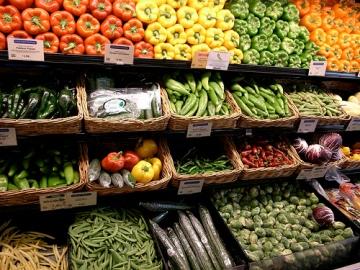
Section Branding
Header Content
Schools Balance Nutrition And Cost
Primary Content

Cafeteria manager Ronda Moss sits at her desk in a little room off the bustling cafeteria at West Chatham Elementary School in Pooler.
She's got stacks of invoices, price lists and nutrition plans in front of her and about 300 kids to feed in a couple of hours.
She's managed school lunchrooms for 30 years and says it's never been more challenging than now.
"The meats, the main entree items are usually the most expensive and then the fruits and vegetables," Moss says.
School lunches recently got their biggest update in 15 years thanks to new guidelines from the U.S. Department of Agriculture.
The rules now set limits on calories and salt.
They phase in whole grains and require at least one vegetable or fruit per meal.
Today, the kids at West Chatham are getting tater tots made not with white but more nutritious sweet potatoes.
Moss points to them baking in a six foot tall stainless steel oven.
"I see a few more trying them each time we serve them so hopefully everyone will eventually try them," Moss says.
The healthier foods cost a little more.
And so elementary and middle school students here now pay $2.25 cents for lunch instead of $2. Moss says, reaction has been mixed.
Some students are now bagging lunch.
But most are adjusting to the new normal.
"New regulations really reflect a positive towards a nutritious diet toward for the children. This is a learning environment," Moss says. "We start with them young and teach them some good choices and hopefully they'll continue to make good choices as they grow older."
All Chatham County schools now practice "meatless Monday."
And across the state districts are trying and succeeding with similar ideas.
Rockdale County school foods director Peggy Lawrence is national spokeswoman for the School Nutrition Association.
She says the budget impacts actually are hardest on wealthier suburban systems and those that don't cook a lot from scratch.
"You have a system, maybe, with more affluent populations so your free and reduced meal eligibility is lower, which is typically going to mean less federal funds coming in," Lawrence says. "And maybe you are a system that does all convenience-processed foods which tend to cost more."
In some systems, higher prices have led to a slight drop in kids that buy the lunches, compounding a healthy food "ick" factor.
Lawrence says, the biggest challenge is getting students to buy into the menus.
"We can write really great looking menus on paper, but we've got to get children to consume the food," Lawrence says. "I've joked in the past that we could have the healthiest trash cans in the state, but not the healthiest kids."
With schools just a few weeks into the new program, officials locally and nationally say, it's still to early to tell just how much on an impact the guidelines will have on cafeteria bottom lines.
Many districts are phasing in the changes to give students time to adapt.
Tags: school, U.S. Department of Agriculture, Chatham County, GPBeducation, Peggy Lawrence, Lunch, Cafeteria Man, Ronda Moss
Bottom Content

